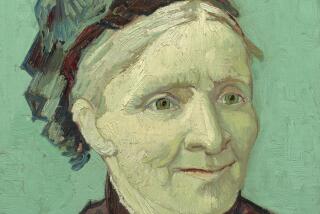Brushes, With Greatness : Between Hungary and ‘America,’ Ferenc Daday’s Life Canvas Includes Eva Peron and Richard Nixon
- Share via
Not too many people can say they’ve kissed the hand of Evita.
No, not the hand of Madonna--who asks Argentina not to cry for her in the film “Evita,” now in limited release--but the real Eva Peron, who captured the heart of that country a half-century ago.
“Evita said to me, ‘Are you European?’ because I kissed her hand,” recalled Ferenc Daday, 82, whose landscapes and portraits are on display at the Richard Nixon Library & Birthplace in Yorba Linda through Jan. 12.
“For me it was most natural to kiss her hand,” Daday said. “It would have been a terrible thing to do for an Argentinian.” (Well, not terrible, perhaps, but a handshake would have been more the custom, he later explained.)
It was the first of many meetings Daday would have with Peron.
The exhibit at the Nixon library, “A Hungarian America,” features 27 watercolors and oil paintings depicting landscapes, cowboy scenes and Daday’s travels. His work as a muralist for Juan and Eva Peron prepared him for his “Nixon at Andau” (1972), a 6-foot-by-10-foot oil on canvas on permanent display at the library. (In 1956, President Dwight D. Eisenhower sent then-Vice President Nixon to the Austrian town to meet Hungarian refugees fleeing Soviet tanks in Budapest.)
In 1947, Daday, who retains a thick Hungarian accent, went to Stockholm, then continued to Buenos Aires. His first job there was for a remodel of a Hungarian restaurant. The country’s minister of culture saw Daday’s work at the restaurant reopening and hired him for several public works projects.
One of those, according to Daday, was a pet project of Evita’s, “a children’s town” at Belgrano called Ciudad Infantil.
“Everything was built--the bank, the schools, the hospitals--the same scale for little kids,” said Daday, who now lives in Mission Viejo. “Evita brought the children from remote places, from the interior, the little children who had never seen what is working in a city, the factories. [The town] was about four to eight blocks, and in a dormitorio, they’re living there, the kids.”
Daday painted several murals for the town, whose purpose seems to have been primarily educational. One mural was for the Salon de Actos amphitheater and another for a dining room where president Juan Peron would receive guests.
Evita Peron scheduled a visit to the town to monitor its progress, and Daday recalled the circumstances of their first meeting.
“It was all set for Evita to see,” Daday recalled. “But she don’t appear. Every people [working on the town] was there. ‘Evita, Evita!’ But she doesn’t come somehow. Maybe coming the next day, but the next day a few people was waiting less. The third day came a terrible rain, was pouring . . . and nobody waited for her.
“I was working on this dining room wall, and I heard from behind me the boy [who was] helping me wash the brushes, ‘She is coming, Evita. . . . Here is Evita, here is Evita!’ I am a newcomer. If I talk to her, I am only beginning in Spanish. If I don’t turn around, [in a sense] I can tell her more. . . .
“I saw that she came in with her secretary, nobody else. They stopped behind me, watching me working, and Evita is saying, ‘Miracle, a miracle, fantastico. . . . You see how art is born!’ It was charcoal only; I had only started the wall. It was then that I turned back and kissed her hand.”
Daday settled in California in 1955. He became a U.S. citizen five years later and was appointed to the national Advisory Committee on the Arts. In 1981, he presented a portrait of Ronald Reagan to the then-president at the White House.
*
But memories of Argentina remain his most vivid.
“When Evita died, I was painting [in the Argentine city of] Mercedes,” Daday said. “The people came with torches and were praying; the whole city was in black.
“The same day I got a telegram that my wife would go to the hospital [to have our] baby. . . . I could hardly get home to Buenos Aires. Everything stopped--stopped buses, stopped trains. I finally get home, but I cannot get a bouquet of flowers to bring for my wife. In the whole city, all flowers went for Evita. . . . The next day my daughter was born.”
* “A Hungarian America: Landscapes and Portraits by Ferenc Daday,” an exhibit of watercolors and oil paintings, through Jan. 12 at the Richard Nixon Library & Birthplace, 18001 Yorba Linda Blvd., Yorba Linda. Monday-Saturday 10 a.m.-5 p.m., Sunday 11 a.m.-5 p.m. (714) 993-3393.
More to Read
The biggest entertainment stories
Get our big stories about Hollywood, film, television, music, arts, culture and more right in your inbox as soon as they publish.
You may occasionally receive promotional content from the Los Angeles Times.










